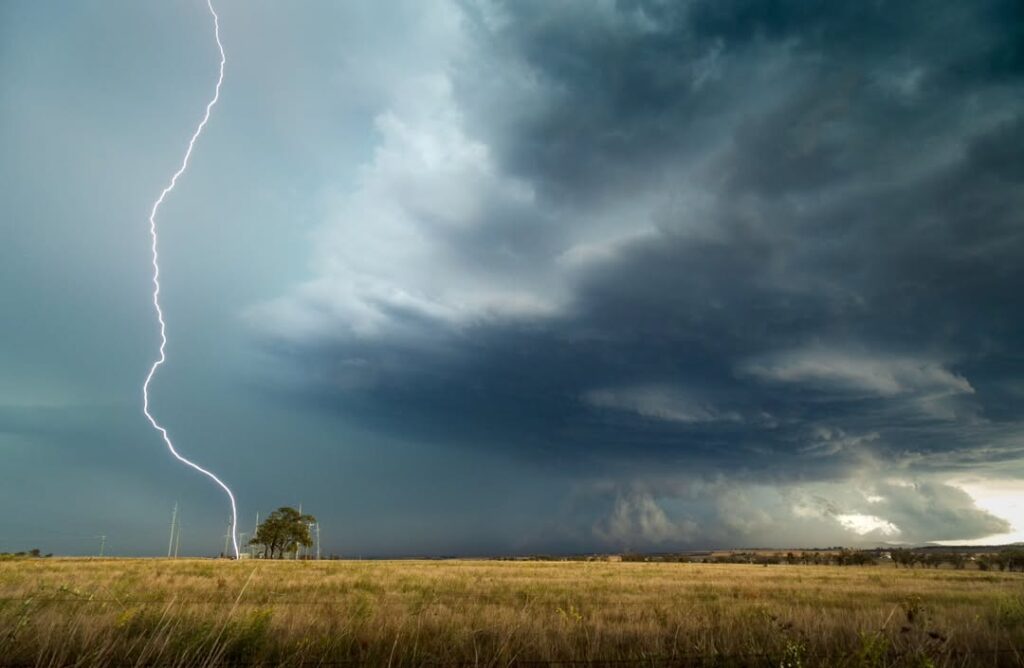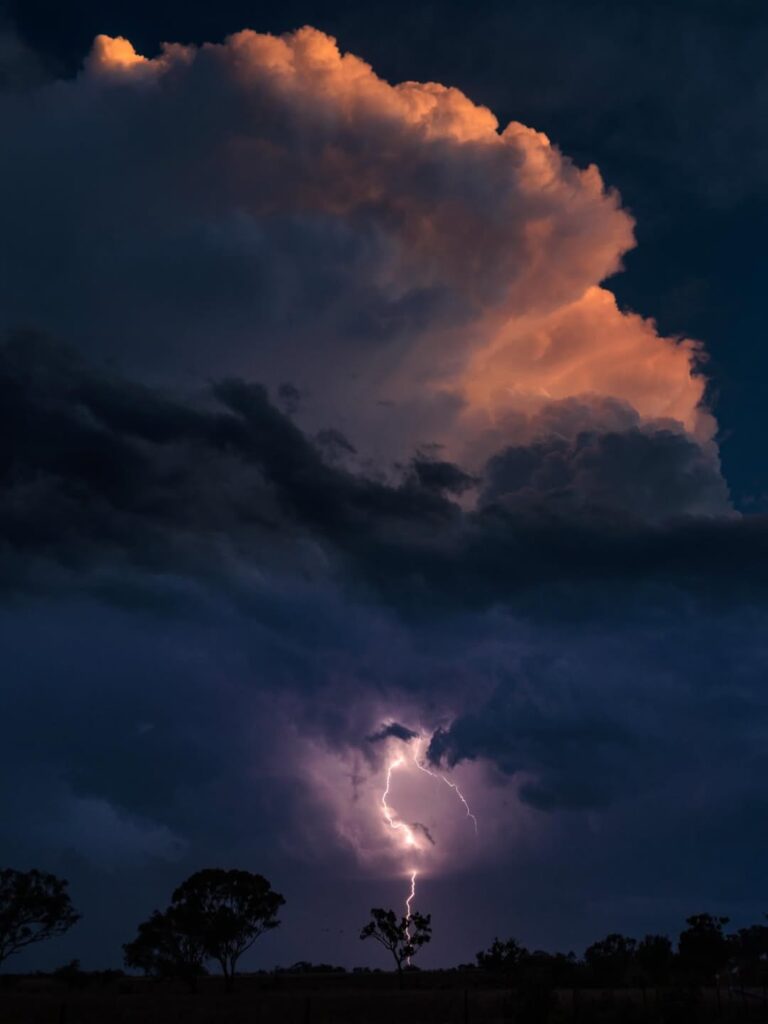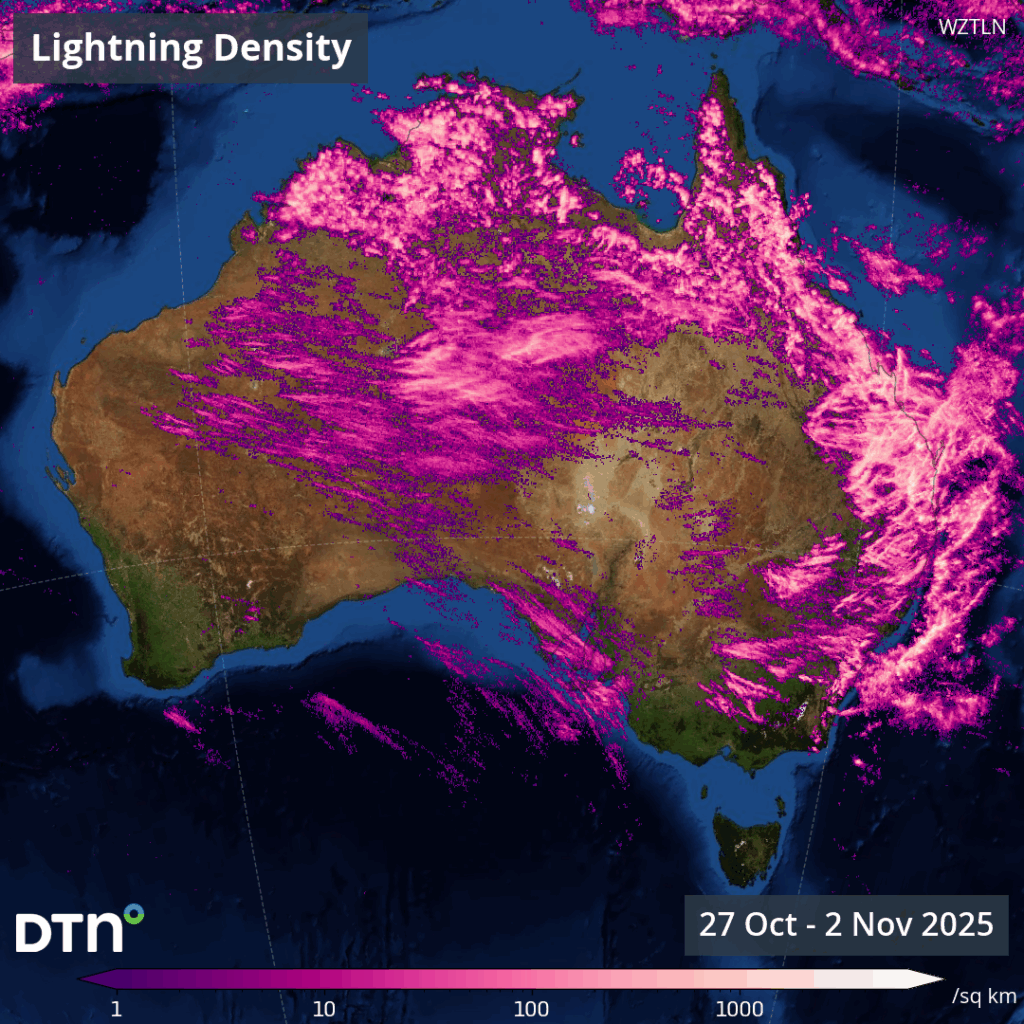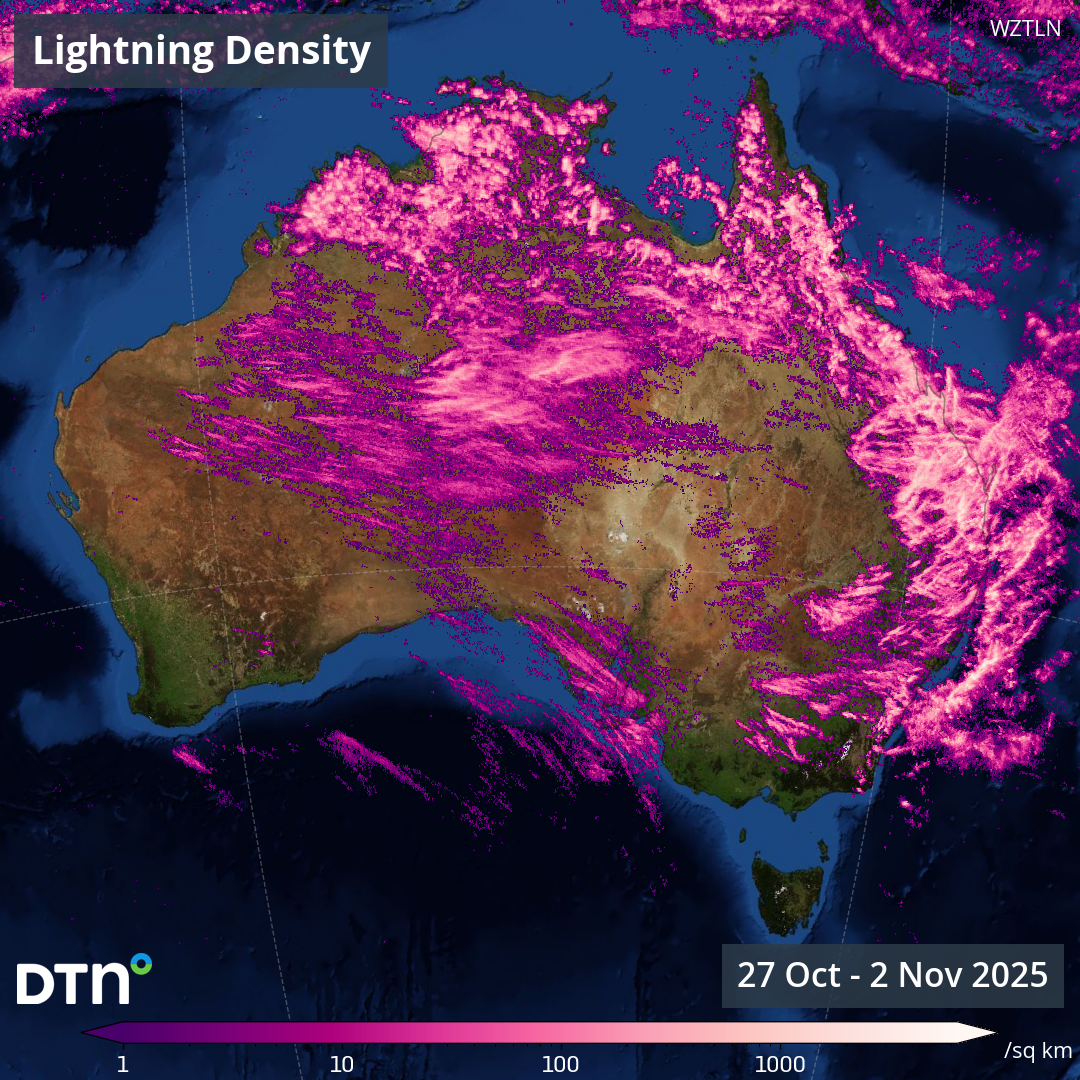A barrage of thunderstorms battered large areas of eastern and northern Australia over the past week, producing close to 8 million lightning pulses across the country and more than 4 million over Queensland alone.
DTN’s Total Lightning Network (TLN) detected around 7.79 million lightning pulses above Australia last week. This lightning was observed over every mainland state and territory and included numerous days of severe thunderstorms.

Image: A thunderstorm causing a cloud-to-ground lightning strike near Greenmount, Qld on Sunday, November 2, 2025. Source: @_benjaminfraser / Instagram.
The 7.79 million lightning pulses that were detected across Australia last week equates to roughly 10% of the country’s average annual lightning activity.
Last week’s thunderstorms were particularly intense over parts of Queensland and NSW, where ample instability, moisture and wind shear created an ideal environment for supercells – the most dangerous type of thunderstorm.

Image: Lightning near Allora, Qld on Friday, October 31, 2025. Source: @my_australia_downunder / Instagram.
Hail measuring 5 to 10cm in diameter hit the ground in Queensland on multiple days last week, including 9cm hail at Pratten on Saturday and 8cm hail at Googa Creek on Sunday. Wind gusts also reached 104 km/h at Cloncurry and Dalby during the weekend’s severe storms, while a gust of 137 km/h was also reported in a violent storm at Territory Grape Farm in the NT on Sunday. This was the strongest wind gust on record for Territory Grape Farm, with wind observations dating back to 1987.
Lightning brings a serious risk of injuries and death to outdoor workers, significant damages to assets and vehicles, and general disruptions to operations. The DTN Total Lightning Network is a key consideration across many mining, transport, utilities, port and maritime operations. If your business or supply chain operates out in the open or in the air, your company could be at risk.
The map below shows where last week’s lighting occurred over Australia, with the highest lightning densities detected across northern and eastern parts of the country.

Image: Lightning detected over Australia by DTN’s TLN between Monday, October 27 and Sunday, November 2, 2025.
Late October and early November is typically a stormy time of year for eastern and northern Australia as the key ingredients required for thunderstorm formation – heat, instability and moisture – typically occur in abundance.
This week will feature more storms across the country, with severe thunderstorms likely over parts of eastern Australia on Monday, and lightning then becoming prolific across WA by Wednesday.
With thunderstorms a regular feature in Australia at this time of year, DTN allows you to visualise approaching storms as our customisable GIS system, Stormtracker, plotting lightning strike data across your site and infrastructure. This enables enhanced understanding of the potential risk inherent in each severe weather system and how storms produce hazardous conditions. Integrated satellite technology improves tracking accuracy, while real-time weather forecasts provide deeper insights into developing thunderstorm activity and potential disruptions.
Personal push notifications give users real-time severe weather and lightning alerts, based on their phone’s GPS position, enhancing their awareness of personal risk. Users can see lightning as it happens and track associated precipitation, ensuring more informed decision-making.
Lightning strike history is archived for over five years, enabling you to extract the reportable data required for risk assessments or insurance claims, with advanced calculation tools ensuring precise analysis.
How DTN APAC is helping remote mining, transport, fire services and agricultural industries with advanced weather intelligence, remote sensing and now-casting solutions during the severe weather season
Australia is a vast country with densely populated coastal areas across the south and east, and millions of square kilometres of sparsely populated and rich in resources elsewhere. Typical radar coverage extends to a radius of about 200km, however mountains, trees and towers can restrict this optimal coverage range. Even with over 60 radar sites operating across Australia, vast expanses of the outback and WA remain outside of this traditional radar coverage, as seen in the left image below.

Image: Comparison of traditional radar coverage and detected rainfall (left), and DTN’s Oracle and TLN (right), across Australia at 1am AEST on Tuesday, September 9, 2025.
The image on the right shows DTN’s Oracle rainfall and Total Lightning Network detecting a vast area of rain and thunderstorms that would have been missed by traditional detection methods.
DTN Oracle
High-Resolution Modelling
Oracle is a satellite-derived, gridded nowcasting system. It forecasts out to 3 hours at a 1-2km resolution, and rapid updates every 5 minutes. With this enhanced forecasting detail, Oracle has the upper hand over 9-12km resolution models when capturing temperature, lightning, cloud cover, wind and rainfall. This ensures that no matter where you are in Australia, you will have access to precision nowcasting and forecasting that can rapidly inform your critical business decisions.
Greater Situational Awareness
Working in conjunction with DTN APAC’s Stormtracker GIS system, Oracle provides full situational awareness of any severe weather event that presents risk to your business. Short-term forecasting and severe weather alerts enable you to foresee the intensity and duration of events, so you can prioritise the safety and preparation of your staff and assets.
Whatever the weather, we provide the insights to help keep you and your team safe, productive and profitable.
DTN Total Lightning Network
Our Total Lightning Network is the intelligent lightning solution that goes above and beyond to alert lightning and increase your lead time before the storm hits.
We utilise a vast global sensor network, created with our partner Earth Networks. Over 1200 sensors in 40+ countries provide a worldwide view of both intra-cloud (IC) and cloud-to-ground (CG) lightning strikes, enabling businesses to plan and respond with the most precise insight available. Our system can detect and calculate strike locations with incredible accuracy, offering real-time lightning mapping for a comprehensive view of storm activity.
Offering unsurpassed accuracy, with real-time sensing to <200m, we integrate with your existing systems to keep your enterprise operating within your defined severe weather thresholds. Our technology also helps monitor radiation from electrical discharges and ensures every lightning flash is accounted for.
Leave nothing to chance. Be confident working outdoors with the most sophisticated lightning alerting system, delivering intelligence to any device across your business network. Whether you need a personal lightning alerting tool for individual safety or enterprise-wide monitoring, our solution is designed to emit timely alerts and protect your operations.
Learn more about our large range of industry leading products and services or email us at sales.apac@dtn.com






